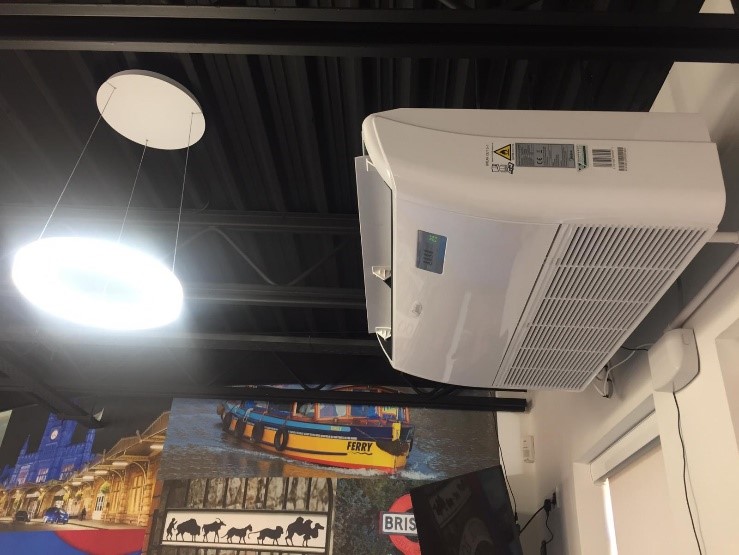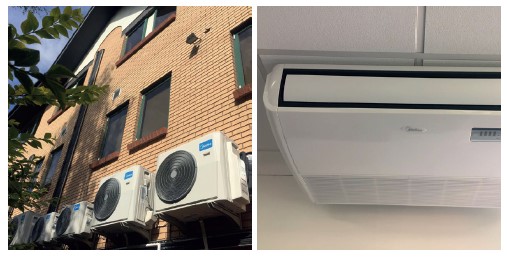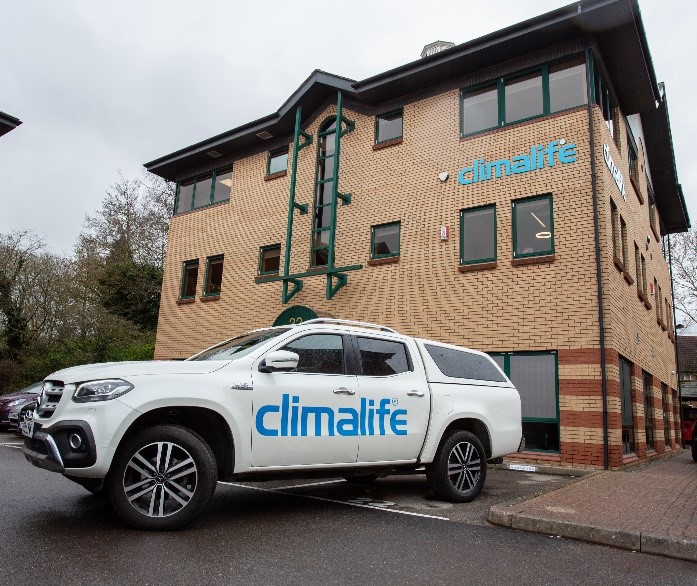Early 2020, the office was totally renovated and kitted out with excellent new staff facilities, supporting the company’s wellbeing culture.
As part of the project, Climalife wanted the new offices to be air conditioned and comfort cooled so that the working environment could be made as comfortable, safe and healthy as possible.
The building has three floors and is made up of several small offices, open plan offices, breakout areas and a small computer room. It was important that the solution implemented was suitable for the complete building structure and that it also met the team’s wellbeing.
When deciding on the air conditioning equipment for the new office, our requirements for the system were clear. It had to include the following technical features:
• Compatible with an A2L refrigerant using the lowest GWP
• Offer energy efficiency
• Split units and larger units for use in different rooms
• Good overall cost
• Long life cycle for the equipment and refrigerant
• Modern and aesthetically pleasing design
“As a business, we are committed to being socially and environmentally responsible, so it was important that we selected a system that would meet our environmental goals. We wanted to design an office that was future-proof for our business whilst also minimising the environmental impact, therefore we needed a HVACR system that would meet these criteria too” explained Allan Harper, Managing Director of Climalife UK.
Selecting the right Refrigerant
Climalife knew straight away that it wanted to use a refrigerant with the lowest GWP possible. This was a crucial step to be sure the equipment and its refrigerant could have a long lifespan and that it would be environmentally sustainable. With its extensive refrigerant knowledge, Climalife UK knew that an A2L refrigerant would have the relevant properties to help deliver the overall objectives for the installation, and so set to seek out the right solution for the project.
Climalife contacted a number of contractors, asking them to recommend, quote and install the new system and its refrigerant. After receiving a number of different quotes, a pattern seemed to be emerging in that none were suggesting the use of an A2L refrigerant. This was a surprise for the team who assumed that contractors would offer A2L systems, but they were offering R-410A, an A1 refrigerant with a GWP of 2088.
Whilst R-410A falls within the allowable range of refrigerants that can be used right now (ie it has a GWP <2500), it would potentially in the future be caught up in availability issues and future bans.
With many equipment manufacturers focusing to phase out the use of R-410A with new lower GWP alternatives already proven to be compatible with system types such as the ones we required, it just wasn’t an option that Climalife wanted to consider.
“Originally we wanted to use equipment that ran on an extremely low GWP refrigerant (<400 GWP). We knew the refrigerants were available from producers Honeywell and Chemours; and that it would be suitable for use, however finding the compatible equipment proved to be much harder than we thought. We then came to the conclusion to use R-32 as we thought we could source suitable equipment easily and were happy that therefrigerant still held a relatively low GWP value of 675.” said Allan Harper.
Selecting the right Equipment

The equipment required had to be compatible with the chosen refrigerant; R-32. Climalife was looking for a number of split systems for individual offices but also needed a number of larger 16-18 Kw multi split systems for the larger open plan areas.
At the beginning of 2020, this type of equipment was not available from most of the large manufacturers based in Japan, who only had at the time small split systems available but because of the larger open plan areas the team required larger units with a bigger cooling capacity.
Climalife turned to one of its distributor customers to see if they had any new ideas on equipment and a contractor that we could use for the project.
The distributor, Richard Stewart from Air Conditioning Accessories introduced Darren Cromack from Glide Air Conditioning and together the three companies looked at the requirements and options available.
Darren from Glide said “After an initial conversation around the design and installation of a full R-32 AC system for their newly acquired office, it was clear there was no other alternative to use R-32 due to the much lower levels of GWP in comparison to R-410A. Following our design meetings, we approached a number of manufacturers only to be faced with the dilemma that at the time of design, they only manufactured R-32 systems up to 10 Kw. In any other typical design, the building would have warranted a VRF/VRV Installation. The team were willing to compromise on independent heating and cooling in each space in the interest of lowering the GWP with R-32.”
Richard Stewart of Air Conditioning Accessories held conversations with equipment manufacturer Midea to find out what new to market equipment they could offer.
Midea advised very quickly that they could supply a 16 to 18 Kw multi split option, which would enable an install of 19 indoor units off only eight condensers, all containing R-32 refrigerant.
Calculations and Design
After initial outline drawings were submitted and the design process was started in accordance with EN 378, the cooling duty in each area was calculated to ensure that it met accurately with the requirements. There were several design considerations to be addressed such as ceiling height limitations, aesthetics, controls and A/C unit selection and fresh air requirements for each zone.
Darren explained “Climalife also requested a heat recovery system for the fresh air and extract for the building. Again, we went with Midea equipment and installed five heat recovery systems.”
A Bacharach leak detection system was also due to be installed on site, it consisted of 15 individual sensors; one for each air-conditioned space.
The Install
The installation took a total of six weeks to install by Darren and his team at Glide Air Conditioning. Darren reported “There is very little difference between installing R-32 kit compared to R-410A as the installation and commissioning process is practically identical. We will be guiding our customers towards the use of R-32 products.”
Conclusion
We know that today there is more and more A2L refrigerant gas ready equipment coming to the market with bigger cooling capacities and we would encourage end users and contractors to start to use A2L equipment for air conditioning applications to help meet the F-Gas regulations.

A collaboration of expertise
AIR CONDITIONING ACCESSORIES LTD
Founded in 2004 by Richard Stewart, ACA based in Leeds, has established itself into a well-regarded distributor in the Air Conditioning industry, supplying good quality service and top-quality products to its customers.
CLIMALIFE
Climalife is one of the largest packers and fillers of refrigerants in Europe and one of the UK’s leading distributors of low GWP refrigerants, including HFO blends and A2Ls on the market.
GLIDE AIR CONDITIONING
Established by Darren Cromack, after he decided to establish his own company having being an engineer for 24 years. The business is renowned for its personal service and attention to detail from design to install, maintenance and service. Glide Air Conditioning have extensive experience installing R-32 systems.
MIDEA
Established in 1968, Midea is one of the world’s fastest growing companies and a global manufacturer of residential and commercial air conditioning equipment, with factories in 12 countries across the world.

